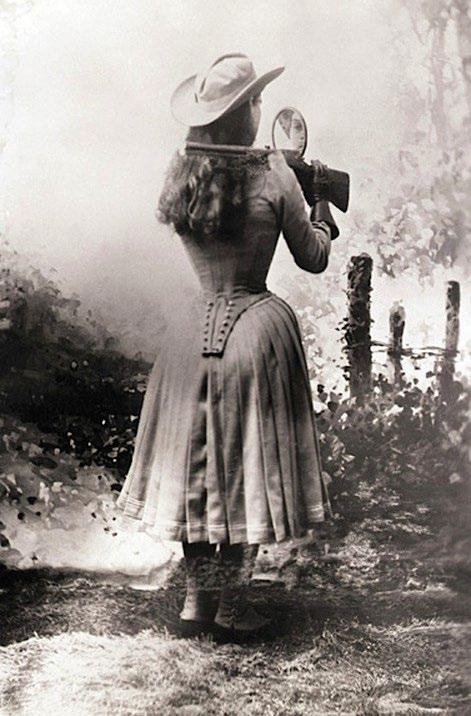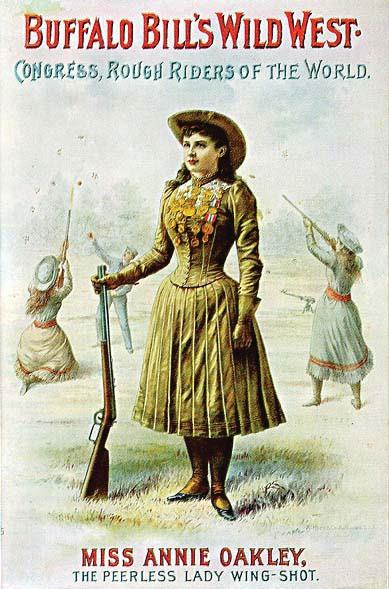
5 minute read
Annie Oakley America’s Most Famous Sharpshooter Was also a Women’s Rights Advocate
Although Annie Oakley’s career drew to a close many years ago, most Americans know her name. Annie was famous for an uncanny proficiency with firearms – particularly rifles.
While in her mid-teens, she defeated professional marksman, Frank Butler, in a celebrated Cincinnati trap shoot still avidly recounted by shooting aficionados. Unable to beat her, Frank joined her within a year as husband and manager.
Later, as the star of “Buffalo Bill” Cody’s Wild West Show, from 1885-1901, she thrilled audiences in the U.S., Canada, and abroad, becoming the highestpaid performer of her time. Her repertoire encompassed stunts like backward shooting (while sighting through a polished Bowie knife) and simultaneously throwing five glass balls into the air, turning a cartwheel, grabbing her Marlin 39 lever-action carbine, and shooting the balls before they hit the ground. Another crowd-dazzler was firing out the flames of burning candles.
Marvelous as these displays were, her most publicized feat accomplished during an 1891 European tour when she shot the ashes off Kaiser Wilhelm II’s lit cigarette. Later, after World War I broke out, Annie herself publicly lamented her unfailing accuracy!

Annie Oakley shooting over her shoulder using a hand mirror.
LIVING LEGEND
Annie became a living legend, but legends fade. A considerable number of 19th Century pioneer women forced to rely on hunting for survival developed remarkable expertise with guns.
The 1880’s Vaudeville circuits featured no less than 16 individuals claiming the title. “Champion Lady Rifle Shot!” Annie’s shooting skill was undoubtedly genuine. But her superstardom, like that of many current celebrities, was achieved mostly through personal charisma coupled with the extraordinary promotional ability of her “imaginative” press agent, John Burket.
AS A “LIBBER”
In time, Annie’s name also became linked with exquisite embroidery and fashion design talents, which she used to make costumes and haute couture gowns. But as a seamstress, the petite Ohioan (barely 5 feet tall) was not unique. Instead, it was the “libber” behind the unique legend.
Throughout her adult life, Annie championed human rights for freedom and aiding the underprivileged. Her participation in charity fund-raisers was well known. Touring for the Red Cross and various other charities, she publicly staged substantial benefits. Her Mineola Racetrack mini-wild west show raised over $11,000 for the Occupational Therapy Society – a hefty sum back then. But few are aware that privately she sent 18 girls through college and supported whole families over long periods.

1880’s poster for Buffalo Bill’s Wild West show, advertising “Miss Annie Oakley, the peerless lady wing-shot.”
Furthermore, despite intense performance schedules, Annie is reported never to have left a single piece of her voluminous fan mail unanswered – with many impoverished fans astonished to discover generous amounts of currency tucked inside those replies. At her performances, Annie would buy out large blocks of seats for orphans, disabled and needy children; many of her leisure hours were spent winding through city ghettos, where she tossed out coins.
In 1894, a profound friendship developed between Annie and Sioux Chief Sitting Bull, who had surrendered to U.S. forces four years earlier. Annie taught him to read and write, and in so doing, developed sympathy for Native American causes. She began protesting by letter and public statements about the government’s terrible treatment of Indians. Sitting Bull, in return, became emotionally attached to her – so much so that he was persuaded to join Cody’s Wild West Show only when promised he could see her every day. Later, he adopted “Little Sure Shot,” as he called her, as his daughter in a special ceremony.

Annie Oakley Cabinet Card Signed, circa 1880s.
It may be a surprise to learn that one of the first personal Christmas cards ever printed contained biting social commentary and was designed and written by none other than Annie.
The card featured her photo on the cover, while the inside contained two Currier & Ives-style prints. The first, labeled “Christmas in the West,” depicted a log cabin with a woman waving to guests arriving by sleigh, while its companion, labeled “Christmas in the East,” showed a tycoon turning beggars away from his estate. Hardly a mere casual greeting to be sure!
AN UNHAPPY CHILDHOOD OF LONELINESS
Underlying, Annie’s social consciousness was a childhood of loneliness and deprivation in which she was no stranger to poverty, discrimination, and injustice. School, where peers cruelly taunted her about her family name, offered little consolation. Those taunts incidentally affected her later decision to change her surname. In time, the undertaking became an obsession, and she went to extreme lengths to alter both private and legal records–even cemetery headstones.
After Annie’s father died, at age 9, Annie offered herself as a hired helper in a private home, only to be severely abused. When she managed to run away two years later, she discovered that her mother had remarried and relocated. After she caught up with her family, the considerable burden for their support quickly fell on her. This she accomplished in the only way she knew: sewing and hunting.
Annie’s quail (she had shot) became coveted in Cincinnati and Dayton’s plush resorts because of her ability to kill them with a rifle. Consequently, they were clean of the shot, riddling those of most other hunters. With her marksmanship, Annie alleged to have paid off the family mortgage. She never forgot these early struggles, which sparked her active protest, social injustice, and unfair working conditions.

Annie Oakley, with gun Buffalo Bill gave her / staff photo. 1922. Photo courtesy of the Library of Congress.
HUMILIATING MEN
Abroad, Annie defeated a string of noblemen in shooting matches, despite warnings against the impropriety of a lady publicly so “humiliating” a man, particularly of high rank. In 1887, when introduced to the Prince of Wales (later King Edward VII), Annie shocked society by ignoring his extended hand and offering hers instead to the Princess. On her European tour four years later, she wrestled Bavarian Prince Regent Luitpold to the ground, rescuing him from a bucking bronco that had become unruly during a rehearsal, she had invited him to attend. These unprecedented actions and her independence ingratiated Annie to Queen Victoria, with whom she subsequently carried on an active correspondence until she died in 1926.

